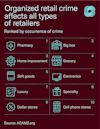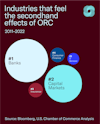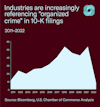 Grant Baker
Grant Baker
Associate Manager, Strategic Advocacy and State and Local Policy, U.S. Chamber of Commerce
 Isabella Lucy
Isabella Lucy
Graphic Designer, U.S. Chamber of Commerce
Published
March 15, 2023
Across the country, communities and businesses, both large and small, are facing a surge in theft and violent crime. This surge is due not to one-time shoplifters but to the rise in highly organized criminal groups—organized retail crime rings.
What is Organized Retail Crime?
Organized retail crime, also referred to as organized retail theft, is the coordinated theft of merchandise by individuals and groups for the purpose of reselling those goods by passing them off as legitimate goods to unsuspecting buyers, typically online.
Highly Organized
Organized retail theft rings exploit local laws, intentionally stealing no more than the dollar-amount threshold to be considered felony theft, and employing a large number of individuals to commit a large number of thefts just below that threshold.
Not Victimless Crimes
Many of these thefts become violent, and innocent consumers, employees, local communities, and business owners and shareholders bear the costs of rising retail theft. According to the National Retail Federation’s 2022 Retail Security Survey, 8 out of 10 retailers reported increased incidents of violence and aggression this past year.
- 8 out of 108 out of 10 retailers reported increased incidents of violence and aggression this past year
Significant Impact
In 2022, retailer losses, or shrink, amounted to nearly $100 billion dollars, of which organized retail crime is a significant driver.
Chamber Action
The U.S. Chamber is committed working with federal, state, and local policymakers to address this serious issue.
At the federal level, the U.S. Chamber worked as part of a broad coalition to pass the INFORM Act, which takes the critical step of removing criminals’ access to online marketplaces by requiring that high-volume third-party sellers disclose and verify their identity.
Encourage states to pass laws defining organized retail theft as a separate offense and pushing local prosecutors to prosecute offenders to the fullest extent of the law.
Encourage coordination among federal, state, and local law enforcement entities to bring these groups to justice.
Read more: Organized Retail Crime 101
How does ORC Impact your State and What is Being Done?
Organized retail crime by the numbers
Click on a state to see more information.
Organized retail crime has a significant impact across the country, with communities nationwide experiencing widespread economic repercussions due to organized retail crime:
- $125.7Bin economic losses nationwide
- $39.2Bin lost wages nationwide
- 685,374jobs lost nationwide
- $14.9Bin lost federal, state, and local tax revenue
This lost revenue has the potential to add to the tax burden which will be carried by the average citizen in other areas like income and business taxes
$68,891,475,371 in goods stolen from retailers across the country as businesses are facing the brunt of organized retail crime. This was equal to 1.47% of all sales, and equated to theft of $214 per capita nationwide.
Thirty-two states have passed legislation to address organized retail crime. These laws range from establishing organized retail crime task forces to defining organized retail crime as a separate offense.
Download the data: Losses due to ORC by state
Analysis: Read More at the Chamber’s Retail Crime landing page
ORC Average Theft
Retail theft is rapidly growing—the average theft rose from $937 in 2020 to $1180 in 2021, while overall theft grew from $219,618,232 to $241,276, 985 during that same time.
- $21.6Bincrease in theft from 2020 to 2021
- $243increase in average theft from 2020 to 2021

Analysis: Read more on what business owners need to know
Small Business
Over half of small businesses say they have been targeted by retail theft, while nearly half say the issue has gotten worse.

Analysis: Small Retailers Say In-Store Theft Is Getting Worse
ORC Affects all Retailers
Retailers of all types are impacted by organized retail crime, which is a significant drain on targeted industries and the economy at large.
From most to least frequently, these criminal groups primarily target: Pharmacies, big box stores, home improvement stores, grocery stores, soft goods stores (sellers of textiles, apparel, fabrics, and similar goods), electronics stores, luxury retail, specialty stores, dollar stores, and cell phone stores.

Organized Retail Crime Impact Beyond Retail
Organized retail crime has caused $125.7 billion in lost economic activity and a loss of 658,375 jobs. While the impact of this may be primarily felt by retailers, it is having a ripple effect across the entire economy, and sectors beyond retail are taking notice of its macroeconomic impact.

Financially-oriented industries are taking notice of the issue of organized retail crime, showing the significant impact this issue is having on the larger economy. From most mentions of organized retail crime to least mentions in an analysis of 10-K filings: Banks, Capital Markets, Consumer Finance, Insurance, and IT Services.

Closing
The U.S. Chamber is committed to working with partners across the business community, civic organizations, and policymakers at the federal, state, and local levels to address the serious issue of organized retail crime. For more information on our work in this critical area, please contact Tom Wickham at twickham@uschamber.com.
About the authors

Grant Baker
Grant Baker is the Associate Manager for Strategic Advocacy and State and Local Policy at the U.S. Chamber of Commerce.








